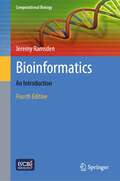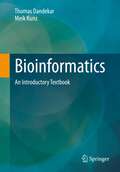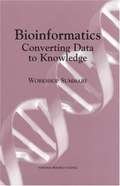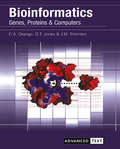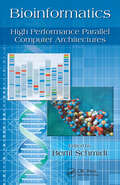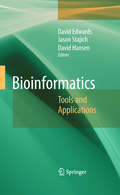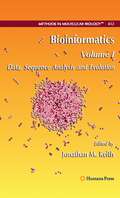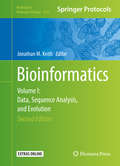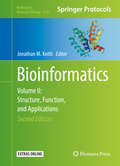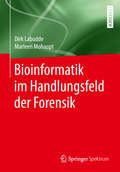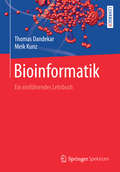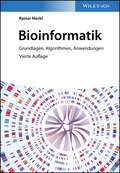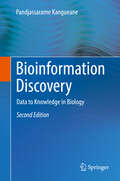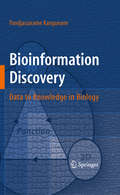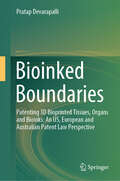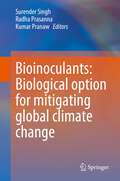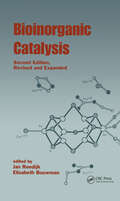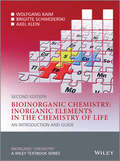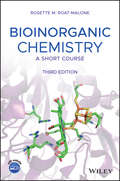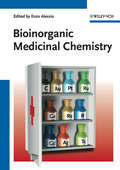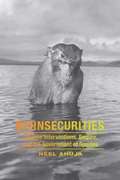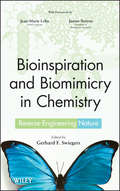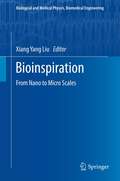- Table View
- List View
Bioinformatics: An Introduction (Computational Biology)
by Jeremy RamsdenThis invaluable textbook presents a self-contained introduction to the field of bioinformatics. Providing a comprehensive breadth of coverage while remaining accessibly concise, the text promotes a deep understanding of the field, supported by basic mathematical concepts, an emphasis on biological knowledge, and a holistic approach that highlights the connections unifying bioinformatics with other areas of science.The thoroughly revised and enhanced fourth edition features new chapters focusing on regulation and control networks, the origins of life, evolution, statistics and causation, viruses, the microbiome, single cell analysis, drug discovery and forensic applications. This edition additionally includes new and updated material on the ontology of bioinformatics, data mining, ecosystems, and phenomics. Also covered are new developments in sequencing technologies, gene editing methods, and modelling of the brain, as well as state-of-the-art medical applications. Of special topicality is a new chapter on bioinformatics aspects of the coronavirus pandemic.Topics and features:Explains the fundamentals of set theory, combinatorics, probability, likelihood, causality, clustering, pattern recognition, randomness, complexity, systems, and networksDiscusses topics on ontogeny, phylogeny, genome structure, and regulation, as well as aspects of molecular biologyCritically examines the most significant practical applications, offering detailed descriptions of both the experimental process and the analysis of the dataProvides a varied selection of problems throughout the book, to stimulate further thinkingEncourages further reading through the inclusion of an extensive bibliographyThis classic textbook builds upon the successful formula of previous editions with coverage of the latest advances in this exciting and fast-moving field. With its interdisciplinary scope, this unique guide will prove to be an essential study companion to a broad audience of undergraduate and beginning graduate students, spanning computer scientists focusing on bioinformatics, students of the physical sciences seeking a helpful primer on biology, and biologists desiring to better understand the theory underlying important applications of information science in biology.Dr. Jeremy Ramsden is Hon. Prof. of Nanotechnology in the Department of Biomedical Research at the University of Buckingham, UK.
Bioinformatics: An Introductory Textbook
by Thomas Dandekar Meik KunzThis book offers a gripping introduction to the fastest growing field of biology with easy-to-follow examples and a well-prepared appendix for the reader to cook up and experience everything right away.The book gets the reader started with the basics, such as how to easily find sequence information and then analyze it. In further chapters, the authors go into the various analysis options from RNA, DNA and proteins to entire metabolic pathways. Exciting examples from biology are chosen in each chapter to illustrate the analysis. Each chapter concludes with an exercise section that immediately puts what has been learned to use.The subject of this book is a must for any biology student, whether undergraduate or graduate, as bioinformatics is now unearthing amazing insights into the molecular basis of all living things. Computer science students and other students from related sciences will get a good introduction to bioinformatics, as biology and current topics (e.g. AI) are systematically introduced step by step alongside the software.Discover the key to life together with the authors and learn to understand the language of life. This book is a translation of the original German 2nd edition Bioinformatik by Thomas Dandekar and Meik Kunz, published by Springer-Verlag GmbH Germany, part of Springer Nature in 2021. The translation was done with the help of artificial intelligence (machine translation by the service DeepL.com). A subsequent human revision was done primarily in terms of content, so that the book will read stylistically differently from a conventional translation. Springer Nature works continuously to further the development of tools for the production of books and on the related technologies to support the authors.
Bioinformatics: Genes, Proteins and Computers (Advanced Texts)
by Christine Orengo, David Jones and Janet ThorntonBioinformatics, the use of computers to address biological questions, has become an essential tool in biological research. It is one of the critical keys needed to unlock the information encoded in the flood of data generated by genome, protein structure, transcriptome and proteome research.Bioinformatics: Genes, Proteins & Computers covers both the more traditional approaches to bioinformatics, including gene and protein sequence analysis and structure prediction, and more recent technologies such as datamining of transcriptomic and proteomic data to provide insights on cellular mechanisms and the causes of disease.
Bioinformatics: High Performance Parallel Computer Architectures (Embedded Multi-Core Systems)
by Bertil SchmidtNew sequencing technologies have broken many experimental barriers to genome scale sequencing, leading to the extraction of huge quantities of sequence data. This expansion of biological databases established the need for new ways to harness and apply the astounding amount of available genomic information and convert it into substantive biological
Bioinformatics: Tools and Applications (Methods in Molecular Biology #Vol. 406)
by David Edwards Jason Stajich David HansenBioinformatics is a relatively new field of research. It evolved from the requirement to process, characterize, and apply the information being produced by DNA sequencing technology. The production of DNA sequence data continues to grow exponentially. At the same time, improved bioinformatics such as faster DNA sequence search methods have been combined with increasingly powerful computer systems to process this information. Methods are being developed for the ever more detailed quantification of gene expression, providing an insight into the function of the newly discovered genes, while molecular genetic tools provide a link between these genes and heritable traits. Genetic tests are now available to determine the likelihood of suffering specific ailments and can predict how plant cultivars may respond to the environment. The steps in the translation of the genetic blueprint to the observed phenotype is being increasingly understood through proteome, metabolome and phenome analysis, all underpinned by advances in bioinformatics. Bioinformatics is becoming increasingly central to the study of biology, and a day at a computer can often save a year or more in the laboratory. The volume is intended for graduate-level biology students as well as researchers who wish to gain a better understanding of applied bioinformatics and who wish to use bioinformatics technologies to assist in their research. The volume would also be of value to bioinformatics developers, particularly those from a computing background, who would like to understand the application of computational tools for biological research. Each chapter would include a comprehensive introduction giving an overview of the fundamentals, aimed at introducing graduate students and researchers from diverse backgrounds to the field and bring them up-to-date on the current state of knowledge. To accommodate the broad range of topics in applied bioinformatics, chapters have been grouped into themes: gene and genome analysis, molecular genetic analysis, gene expression analysis, protein and proteome analysis, metabolome analysis, phenome data analysis, literature mining and bioinformatics tool development. Each chapter and theme provides an introduction to the biology behind the data describes the requirements for data processing and details some of the methods applied to the data to enhance biological understanding.
Bioinformatics: Volume I: Data, Sequence Analysis and Evolution (Methods in Molecular Biology #452)
by Jonathan M. KeithIn this book, leading researchers in the field of Bioinformatics provide a selection of the most useful and widely applicable methods, able to be applied as is, or with minor variations, to many specific problems. Over 80 authors from around the globe contribute to the two volumes, including many leading experts in their respective subjects. They encompass topics from across the diverse field of bioinformatics through its broad scope, combining to provide an inter-disciplinary collaboration involving biologists, biochemists, physicists, mathematicians, statisticians and computer scientists.
Bioinformatics: Volume I: Data, Sequence Analysis, and Evolution (Methods in Molecular Biology #1525)
by Jonathan M. KeithIn Bioinformatics, leading researchers provide a selection of the most useful and widely applicable methods, able to be applied as is, or with minor variations, to many specific problems. Volume II: Structure, Function and Applications contains methods pertinent to the prediction of protein and RNA structures and the analysis and classification of structures, methods for inferring the function of previously identified genomic elements, chiefly protein-coding genes, medical applications in diagnostics and drug discovery, and "meta-methods" for developers of bioinformatics algorithms. Over 80 authors from around the globe have contributed to the two volumes.
Bioinformatics: Volume II: Structure, Function, and Applications (Methods in Molecular Biology #1526)
by Jonathan M. KeithIn Bioinformatics, leading researchers provide a selection of the most useful and widely applicable methods, able to be applied as is, or with minor variations, to many specific problems. Volume II: Structure, Function and Applications contains methods pertinent to the prediction of protein and RNA structures and the analysis and classification of structures, methods for inferring the function of previously identified genomic elements, chiefly protein-coding genes, medical applications in diagnostics and drug discovery, and "meta-methods" for developers of bioinformatics algorithms. Over 80 authors from around the globe have contributed to the two volumes.
Bioinformatik am Beispiel des SARS-CoV2 Virus und der Covid19 Pandemie (essentials)
by Thomas Dandekar Meik KunzIn diesem Buch werden dem Leser einführend zentrale Ansätze der Bioinformatik entsprechend dem Fluss der genetischen Information von der Sequenzanalyse vom Virusgenom und seinen Proteinen über die Strukturvorhersage hin zu komplexeren Analysen (Interaktionen mit dem Wirt, Immunsystem) vorgestellt. Proteinnetzwerke, Metabolismus und Signalkaskaden erlauben dem Virus, eine hochgefährliche Infektion im Menschen zu erzeugen. Die Bioinformatik leistet wertvolle Hilfestellung bei der Diagnose, der Suche nach Behandlungsmöglichkeiten und vor allem bei der Herstellung von Impfstoffen und dem Vorhersehen des Pandemieverlaufs.Der InhaltBioinformatik ist einfach und schnell anzuwendenErste Detailanalysen (Sequenzen, Proteine, Gene)Analyse von Protein-NetzwerkenBioinformatik in der Infektionsbiologie und medizinische ImplikationenBioinformatik und Covid19 – ein globales PhänomenAnhang: Nützliche Webressourcen und LiteraturstellenDie ZielgruppenStudenten der Biologie und Medizin, die einen ersten Einblick in die Bioinformatik haben möchtenAllgemeines Publikum
Bioinformatik im Handlungsfeld der Forensik
by Dirk Labudde Marleen MohauptDieses Lehrbuch soll Studierenden den Einstieg in die Gebiete der Forensik und Bioinformatik gleichermaßen erleichtern. Anhand eines fiktiven Falls, der sich durch das gesamte Buch zieht, wird die Bioinformatik und deren Grundlagen in das Gebiet der Forensik übertragen. Der Fall deckt eine Vielzahl an biologischen Spuren, sowie deren klassische Analyse ab und definiert neue Handlungsfelder in der Bioinformatik und Forensik.In diesem Werk werden verschiedenste Bereiche der Forensik bioinformatisch aufbereitet: Genetischer Fingerabdruck: Auswertung auf Sequenz- statt auf Profilebene Fingerspuren: krankheitsbedingte bzw. genetisch bedingte VeränderungenUntersuchungen zum Phänotyp einer PersonGrundlegende Erkenntnisse zur Wundheilung sowie zur Blutalterung in- und ex-vivo Dieses Buch zeigt die Notwendigkeit auf, die Forensik um weitere Wissensbereiche zu ergänzen und gibt Einblicke in eine Vielzahl moderner Themen der Forensik wie zum Beispiel Populationsgenetik; Wundaltersbestimmung, Daktyloskopie oder Menschen ohne Fingerabdruck.Vor allem Studierende aus den Lebenswissenschaften sowie Dozierende ebendieser Fachrichtung, werden durch dieses Lehrbuch spannende Einblicke in topaktuelle Fragestellungen bekommen.
Bioinformatik: Ein einführendes Lehrbuch
by Thomas Dandekar Meik KunzDieses Buch bietet eine packende Einf#65533;hrung in das am schnellsten wachsende Gebiet der Biologie mit leicht nachvollziehbaren Beispielen und einem gut aufbereitetem Anhang f#65533;r den Leser, der so gleich alles direkt nachkochen und miterleben kann. Das Buch holt den Leser bei den Grundlagen ab, wie man zum Beispiel Sequenzinformationen einfach erh#65533;lt und analysiert. In weiteren Kapiteln gehen die Autoren auf die verschiedenen Analysem#65533;glichkeiten von RNA, DNA und Proteinen bis hinzu ganzen Stoffwechselwegen ein. Dabei werden in jedem Kapitel spannende Beispiele aus der Biologie gew#65533;hlt, die zur Veranschaulichung der Analyse dienen. Jedes Kapitel wird mit einem #65533;bungsteil abgeschlossen, welches das Gelernte sogleich zur Anwendung bringt. Das Thema dieses Buches ist ein Muss f#65533;r jeden Biologiestudierenden, ob Bachelor- oder Masterstudium, da die Bioinformatik mittlerweile erstaunliche Einsichten in die molekularen Grundlagen aller Lebewesen zutage f#65533;rdert.
Bioinformatik: Ein einführendes Lehrbuch
by Thomas Dandekar Meik KunzDieses Buch bietet eine packende Einführung in das am schnellsten wachsende Gebiet der Biologie mit leicht nachvollziehbaren Beispielen und einem gut aufbereiteten Anhang für die Leserschaft, um so gleich alles direkt nachkochen und miterleben zu können.Das Buch holt den Leser und die Leserin bei den Grundlagen ab, wie man zum Beispiel Sequenzinformationen einfach findet und dann analysiert. In weiteren Kapiteln gehen die Autoren auf die verschiedenen Analysemöglichkeiten von RNA, DNA und Proteinen bis hin zu ganzen Stoffwechselwegen ein. Dabei werden in jedem Kapitel spannende Beispiele aus der Biologie gewählt, die zur Veranschaulichung der Analyse dienen. Jedes Kapitel wird mit einem Übungsteil abgeschlossen, welches das Gelernte sogleich zur Anwendung bringt.Das Thema dieses Buches ist ein Muss für jeden Biologiestudierenden, ob Bachelor- oder Masterstudium, da die Bioinformatik mittlerweile erstaunliche Einsichten in die molekularen Grundlagen aller Lebewesen zutage fördert. Informatikstudierende und andere Studierende aus angrenzenden Naturwissenschaften bekommen einen guten Einstieg in die Bioinformatik, denn neben der Software werden systematisch die Biologie und aktuelle Themen (z.B. KI) Schritt für Schritt eingeführt.Entdecken Sie gemeinsam mit den Autoren den Schlüssel zum Leben und lernen Sie die Sprache des Lebens verstehen.
Bioinformatik: Grundlagen, Algorithmen, Anwendungen
by Rainer MerklBioinformatik Der Marktführer bei den Bioinformatiklehrbüchern in neuer Auflage und mit dem neuen Thema Molekulardynamik Bioinformatik ist eine Kerndisziplin in den modernen Biowssenschaften, von der Biotechnologie über die Biochemie und Molekularbiologie bis zur Molekulargenetik und Molekularmedizin. Sie ist eine essenzielle Grundlage für alle “omics”-Technologien, für die Strukturbiologie, die Systembiologie sowie die synthetische Biologie. Bioinformatik. Grundlagen, Algorithmen, Anwendungen bietet eine umfassende Einführung in die wichtigsten Methoden der Bioinformatik. Der Autor erklärt dabei sowohl die mathematischen und biologischen Grundlagen als auch die wichtigsten Software-Tools und deren Anwendungsbereiche. Schwerpunkte sind Methoden zum Sequenzvergleich, Verfahren zur Charakterisierung von Proteinfamilien, Algorithmen zur Vorhersage von Protein- und RNA-Strukturen, Methoden des maschinellen Lernens und das Proteindesign. Für die 4. Auflage wurde der Text durchgehend aktualisiert und um ein Kapitel zur Molekulardynamik erweitert. Neu aufgenommene Exkurse zu Meilensteinen der Bioinformatik und aktuellen Anwendungsgebieten lockern den Text auf. Auf der ebenfalls komplett überarbeiteten Begleit-Webseite werden interaktive Lernmodule bereitgestellt, einschließlich mehr als 120 Übungsaufgaben, zum Teil mit Lösungen. Eine perfekte Einführung für alle Studenten der Lebenswissenschaften oder Informatik, die einen Einblick in die gängigen Methoden der Bioinformatik benötigen, sowie ein wertvoller Begleiter für alle, die bereits bioinformatische Werkzeuge nutzen und die zugrundeliegenden Konzepte verstehen möchten.
Bioinformation Discovery: Data to Knowledge in Biology
by Pandjassarame KangueaneThis new edition continues to illustrate the power of biological data in knowledge discovery. It describes biological data types and representations with examples for creating a workflow in bioinformation discovery. The concepts in knowledge discovery from data are illustrated using line diagrams. The principles and concepts in knowledge discovery are used for the development of prediction models for simulations of biological reactions and events. Advanced topics in molecular evolution and cellular & molecular biology are addressed using bioinformation gleaned through discovery. Each chapter contains approximately 10 exercises for practice. This will help students to expand their problem solving skills in Bioinformation Discovery. In this new edition, there are three new chapters covering single nucleotide polymorphism, genes, proteins and disease, and protein functions driven by surface electrostatics.
Bioinformation Discovery: Data to Knowledge in Biology
by Pandjassarame KangueaneBioinformation Discovery illustrates the power of biological data in knowledge discovery. It describes biological data types and representations with examples for creating a workflow in Bioinformation discovery. The concepts in knowledge discovery from data are illustrated using line diagrams. The principles and concepts in knowledge discovery are used for the development of prediction models for simulations of biological reactions and events. Advanced topics in molecular evolution and cellular & molecular biology are addressed using Bioinformation gleaned through discovery. Each chapter contains approximately 10 exercises for practice. This will help students to expand their problem solving skills in Bioinformation Discovery. Each chapter concludes with a number of good problem sets to test mastery of the material.
Bioinked Boundaries: Patenting 3D Bioprinted Tissues, Organs and Bioinks: An US, European and Australian Patent Law Perspective
by Pratap DevarapalliThis book presents a comprehensive and comparative study of the patentability of bioprinting inventions, specifically bioinks and bioprinted tissues, in the US, the Europe and Australia. It employs a two-phase analysis to understand, ‘Is the patentable subject matter requirement a hurdle to patenting bioprinting inventions, specifically bioinks and bioprinted tissues?’ The first phase is a doctrinal analysis of the patent laws and jurisprudence in respective jurisdictions, highlighting the similarities and differences in their approaches to the subject matter requirement. The second phase is an empirical analysis of the patent prosecution data from patent applications filed in each jurisdiction with claims directed towards bioprinted tissues and bioinks, revealing how patent examiners apply the patent provisions to accept or object to such patent claims. The book offers several contributions to the field of bioprinting and patent law. First, it provides a detailed and up-to-date overview of the current state of the art and the legal landscape of bioprinting inventions. Second, it identifies the main criteria and factors that patent examiners use to assess the patentable subject matter of bioprinted tissues and bioinks, such as the level of human intervention, the markedly different characteristics, and the industrial applicability. Third, it proposes patenting framework models for each jurisdiction, which can assist patent applicants to draft and amend their patent claims in accordance with the patentable subject matter requirement. Fourth, it evaluates the potential benefits and implications of patenting bioprinting inventions for the bioprinting industry and society at large, such as fostering innovation, promoting public health, and indirectly addressing ethical and social issues. The main benefit that the reader will derive from the book is a deeper understanding of the patentability of bioprinting inventions, specifically bioinks and bioprinted tissues, in different jurisdictions and contexts. The book will help the reader to appreciate the legal and technical aspects of bioprinting and patent law, and how they affect the bioprinting industry and society at large.
Bioinoculants: Biological Option for Mitigating global Climate Change
by Surender Singh Radha Prasanna Kumar PranawThis edited book covers various bioinoculants for sustainable crop production under the changing global climate. The book envisages a compilation of articles relevant to the current status of production and use of novel microbial inoculants for different crops and highlights their role in mitigating global climate challenges. These include nutrient deficiencies, salinity, drought, and emerging pathogens. In addition, success stories and commercialization aspects are also discussed. Growing environmental concerns related to climate change can potentially decrease the global yield capacity of agricultural systems. Agricultural productivity is severely affected by major biotic and abiotic factors. The phytomicrobiome plays a critical role in the survival of the holobiont, particularly for plants growing in extreme environments. The use of microbial-based agricultural inputs has a long history, beginning with a broad-scale rhizobial inoculation of legumes in the early twentieth century. Microbial inoculants are considered one of the best and most effective strategies for sustainable agriculture under climate change, and a viable solution to meet the twin challenges of global food security and environmental sustainability. It is therefore imperative to understand the current status and development in the area of bioinoculants from a global perspective. The chapter’s focus would be on major agro-ecologies, covering all major crops across the globe, along with the commercialization status of different bioinoculants in different countries The book caters to the needs of the students, faculty, policymakers, and researchers working in the area of microbiology, biotechnology, environmental sciences, and botany.
Bioinorganic Catalysis
by Jan Reedijk Elisabeth Bouwman"Provides the latest research results and suggests new topics for interdisciplinary study of metal ions, catalysis, and biochemical systems. Second Edition highlights potential applications; includes new chapters on zinc and FeS clusters; presents new X-ray analysis of metalloenzymes; and more."
Bioinorganic Chemistry -- Inorganic Elements in the Chemistry of Life
by Brigitte Schwederski Axel Klein Wolfgang KaimThe field of Bioinorganic Chemistry has grown significantly in recent years; now one of the major sub-disciplines of Inorganic Chemistry, it has also pervaded other areas of the life sciences due to its highly interdisciplinary nature.Bioinorganic Chemistry: Inorganic Elements in the Chemistry of Life, Second Edition provides a detailed introduction to the role of inorganic elements in biology, taking a systematic element-by-element approach to the topic. The second edition of this classic text has been fully revised and updated to include new structure information, emerging developments in the field, and an increased focus on medical applications of inorganic compounds. New topics have been added including materials aspects of bioinorganic chemistry, elemental cycles, bioorganometallic chemistry, medical imaging and therapeutic advances.Topics covered include:Metals at the center of photosynthesisUptake, transport, and storage of essential elementsCatalysis through hemoproteinsBiological functions of molybdenum, tungsten, vanadium and chromiumFunction and transport of alkaline and alkaline earth metal cationsBiomineralizationBiological functions of the non-metallic inorganic elementsBioinorganic chemistry of toxic metalsBiochemical behavior of radionuclides and medical imaging using inorganic compoundsChemotherapy involving non-essential elements This full color text provides a concise and comprehensive review of bioinorganic chemistry for advanced students of chemistry, biochemistry, biology, medicine and environmental science.
Bioinorganic Chemistry: A Short Course
by Rosette M. Roat-MaloneIntroduces students to the basics of bioinorganic chemistry This book provides the fundamentals for inorganic chemistry and biochemistry relevant to understanding bioinorganic topics. It provides essential background material, followed by detailed information on selected topics, to give readers the background, tools, and skills they need to research and study bioinorganic topics of interest to them. To reflect current practices and needs, instrumental methods and techniques are referred to and mixed in throughout the book. Bioinorganic Chemistry: A Short Course, Third Edition begins with a chapter on Inorganic Chemistry and Biochemistry Essentials. It then continues with chapters on: Computer Hardware, Software, and Computational Chemistry Methods; Important Metal Centers in Proteins; Myoglobins, Hemoglobins, Superoxide Dismutases, Nitrogenases, Hydrogenases, Carbonic Anhydrases, and Nitrogen Cycle Enzymes. The book concludes with chapters on Nanobioinorganic Chemistry and Metals in Medicine. Readers are also offered end-of-section summaries, conclusions, and thought problems. Reduces size of the text from previous edition to match the first, keeping it appropriate for a one-semester course Offers primers and background materials to help students feel comfortable with research-level bioinorganic chemistry Emphasizes select and diverse topics using extensive references from current scientific literature, with more emphasis on molecular biology in the biochemistry section, leading to a discussion of CRISPR technology Adds new chapters on hydrogenases, carbonic anhydrases, and nitrogen cycle enzymes, along with a separate chapter on nanobioinorganic chemistry Features expanded coverage of computer hardware and software, metalloenzymes, and metals in medicines Supplemented with a companion website for students and instructors featuring Powerpoint and JPEG figures and tables, arranged by chapter Appropriate for one-semester bioinorganic chemistry courses, Bioinorganic Chemistry: A Short Course, Third Edition is ideal for upper-level undergraduate and beginning graduate students. It is also a valuable reference for practitioners and researchers in need of a general introduction to the subject, as well as chemists requiring an accessible reference.
Bioinorganic Medicinal Chemistry
by Enzo AlessioThis book gives a comprehensive overview about medicinal inorganic chemistry. Topics like targeting strategies, mechanism of action, Pt-based antitumor drugs, radiopharmaceuticals are covered in detail and offer the reader an in-depth overview about this important topic.
Bioinsecurities: Disease Interventions, Empire, and the Government of Species
by Neel AhujaIn Bioinsecurities Neel Ahuja argues that U.S. imperial expansion has been shaped by the attempts of health and military officials to control the interactions of humans, animals, viruses, and bacteria at the borders of U.S. influence, a phenomenon called the government of species. The book explores efforts to control the spread of Hansen's disease, venereal disease, polio, smallpox, and HIV through interventions linking the continental United States to Hawai'i, Panamá, Puerto Rico, Cuba, Congo, Iraq, and India in the twentieth and twenty-first centuries. Ahuja argues that racial fears of contagion helped to produce public optimism concerning state uses of pharmaceuticals, medical experimentation, military intervention, and incarceration to regulate the immune capacities of the body. In the process, the security state made the biological structures of human and animal populations into sites of struggle in the politics of empire, unleashing new patient activisms and forms of resistance to medical and military authority across the increasingly global sphere of U.S. influence.
Bioinspiration and Biomimicry in Chemistry
by Janine Benyus Jean-Marie Lehn Gerhard SwiegersCan we emulate nature's technology in chemistry?Through billions of years of evolution, Nature has generated some remarkable systems and substances that have made life on earth what it is today. Increasingly, scientists are seeking to mimic Nature's systems and processes in the lab in order to harness the power of Nature for the benefit of society.Bioinspiration and Biomimicry in Chemistry explores the chemistry of Nature and how we can replicate what Nature does in abiological settings. Specifically, the book focuses on wholly artificial, man-made systems that employ or are inspired by principles of Nature, but which do not use materials of biological origin.Beginning with a general overview of the concept of bioinspiration and biomimicry in chemistry, the book tackles such topics as:Bioinspired molecular machinesBioinspired catalysisBiomimetic amphiphiles and vesiclesBiomimetic principles in macromolecular scienceBiomimetic cavities and bioinspired receptorsBiomimicry in organic synthesisWritten by a team of leading international experts, the contributed chapters collectively lay the groundwork for a new generation of environmentally friendly and sustainable materials, pharmaceuticals, and technologies. Readers will discover the latest advances in our ability to replicate natural systems and materials as well as the many impediments that remain, proving how much we still need to learn about how Nature works.Bioinspiration and Biomimicry in Chemistry is recommended for students and researchers in all realms of chemistry. Addressing how scientists are working to reverse engineer Nature in all areas of chemical research, the book is designed to stimulate new discussion and research in this exciting and promising field.
Bioinspiration: From Nano to Micro Scales (Biological and Medical Physics, Biomedical Engineering)
by Xiang Yang LiuMethods in bioinspiration and biomimicking have been around for a long time. However, due to current advances in modern physical, biological sciences, and technologies, our understanding of the methods have evolved to a new level. This is due not only to the identification of mysterious and fascinating phenomena but also to the understandings of the correlation between the structural factors and the performance based on the latest theoretical, modeling, and experimental technologies. Bioinspiration: From Nano to Micro Scale provides readers with a broad view of the frontiers of research in the area of bioinspiration from the nano to macroscopic scales, particularly in the areas of biomineralization, antifreeze protein, and antifreeze effect. It also covers such methods as the lotus effect and superhydrophobicity, structural colors in animal kingdom and beyond, as well as behavior in ion channels. A number of international experts in related fields have contributed to this book, which offers a comprehensive and synergistic look into challenging issues such as theoretical modeling, advanced surface probing, and fabrication. The book also provides a link to the engineering of novel advanced materials playing an important role in advancing technologies in various fields.
